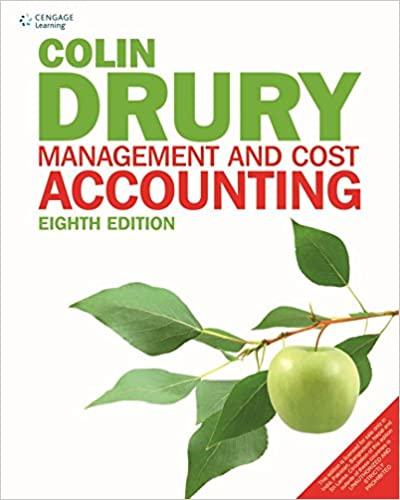In 1996 Insteel Industries decided to implement ABC at the Andrews, South Carolina plant. The ABC team
Question:
In 1996 Insteel Industries decided to implement ABC at the Andrews, South Carolina plant. The ABC team analyzed operations and identified 12 business processes involving a total of 146 activities. The ABC study revealed that the 20 most expensive activities accounted for 87 per cent of Andrew’s total physical and people resource of \($21.4\) million. Within the top 20 activities, almost \($5\) million pertained to qualityrelated activities such as reactive maintenance, management of by-products and scrap and preventive maintenance. The analysis also revealed that material-handling costs, including freight costs, consumed \($4.6\) million. Activities were further classified into value-added and non-value added. Nearly \($4.9\) million was spent on non-value added activities such as reactive maintenance, dealing with scrap, moving materials, reworking products and managing customer complaints. Those activities, within the 20 most expensive, were targeted for cost reduction and process improvement.
The company estimates that within a year of the first ABC study, \($1.8\) million had been saved in quality costs, mainly through a reduction of scrap and reactive maintenance costs. Freight costs were reduced \($555\) 000 in a year in the Andrews plant alone. Non-value added activities were reduced from 22 per cent of activity costs to 17 per cent.
Insteel focused on freight because delivering products to customers represented 16 per cent of the total people and physical resources cost at the Andrews plant. As a part of the ABC study, Insteel started tracking freight cost per pound shipped. This directed attention to ways in which these costs could be reduced. In 1997, by changing the layout of boxes within each truck, the Andrews plant was able to ship 7400 pounds more per truckload.This represented a 20 per cent reduction in freight expense. When Insteel realized how much they were actually incurring in quality costs, the team probed deeper into understanding better what was causing the quality costs to be incurred and for suggesting steps to reduce them.
Insteel realized that certain foreign suppliers of rods were lower in price but supplied poorer-quality rods that caused breakdowns in Insteel’s manufacturing process. The lower price of those suppliers did not compensate for the quality costs. Insteel switched to higher-quality rod suppliers. Insteel also realized that smaller diameter wire products were more likely to break and disrupt the manufacturing process. Insteel migrated its product mix to more large diameter wire products. Such initiatives led to reduction in quality costs from \($6.7\) million in 1996 to \($4.9\) million in 1997. It is hard to estimate how much of these savings would have been realized had Insteel not conducted an ABC analysis. The activity analysis gave them an appreciation of the scope and quantified the magnitude of the improvement potential, thereby allowing them to prioritize among various process improvement possibilities. Clearly ABC served as a focusing device by providing cost data by activities, directing attention to the top 20 activities, and by labelling some of them as non-value added activities.
Question
1 How might activity costs for Insteel differ from departmental costs?
Step by Step Answer:






